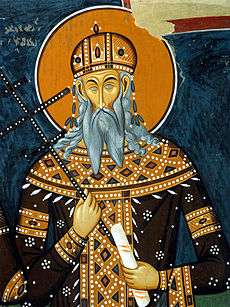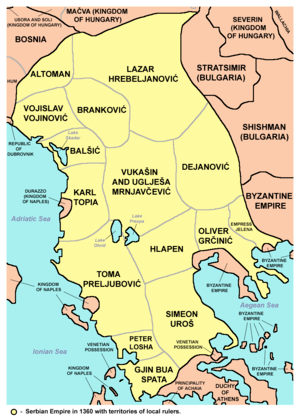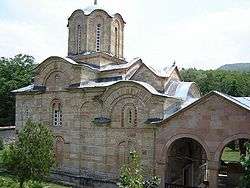Vukašin of Serbia
| Vukašin Mrnjavčević | |
|---|---|
 | |
| King of the Serbs and the Greeks | |
| Reign | 1365 – 27 September 1371 |
| Coronation | 1365 |
| Predecessor | Stephen Uroš V |
| Successor | Marko Mrnjavčević |
| Born |
c. 1320 Livno, Bosnia |
| Died |
27 September 1371 Maritsa, Bulgaria |
| Spouse | Jelena Mrnjavčević |
| Issue |
Marko Mrnjavčević, Andrijaš Mrnjavčević, Dmitar Mrnjavčević, Ivaniš Mrnjavčević, Olivera Mrnjavčević |
| House | House of Mrnjavčević |
| Father | Mrnjava |
| Religion | Serbian Orthodox |



King Vukašin of Serbia, also known as Vukašin Mrnjavčević (Serbian Cyrillic: Вукашин Мрњавчевић, pronounced [ʋukǎʃin mr̩̂ɲaːʋtʃeʋitɕ] (![]()
Background
According to 17th-century Ragusan historian Mavro Orbini, his father was a minor noble named Mrnjava from Zachlumia, whose sons Vukašin and Uglješa Mrnjavčević were born in Livno in western Bosnia.[3] Some of Orbin's historical accounts are based on oral traditions of his time, but a 1280 Ragusan document mentions a Mrnjan as a nobleman from Trebinje, a town in Travunia in the vicinity of Zachlumia.[4] The same Mrnjan is mentioned again in a 1289 charter as a treasurer of the Serbian queen Helen of Anjou.[4][5] After Zachlumia was annexed by Bosnia in 1326, the family of Mrnjan, or Mrnjava, could have moved to Livno. Possibly the family supported Serbian Emperor Dušan's invasion of Bosnia in 1350, as did other Zachlumian nobles, and fearing punishment, emigrated to Serbia when the war was about to start.[6] In favor of Zachumlian or Travunian origin of Vukašin also speaks the inscription on the tomb in a church in Ohrid, where certain Ostoja Rajaković of the Ugarčić clan (died 1379) is referred to as a cousin of Vukašin's eldest son Marko.[5] The Ugarčić clan is attested in contemporary sources as inhabiting the region of Trebinje.[7]
After Serbia had expanded southwards into Macedonia, the local feudal lords—Greeks—were replaced with Serbs, many of whom were from Zachlumia and Travunia.[7][8] In c. 1350 Emperor Dušan appointed Vukašin the župan (district governor) of Prilep in Macedonia.[6][9] From then on Vukašin rapidly rose, and was one of the most dominant Serbian nobles at the time of the sudden death of Dušan in 1355.[6] He was given the title of despot by Dušan's successor Emperor Stefan Uroš V. In 1365 he was crowned King of the Serbs and Greeks as the co-ruler of Emperor Uroš.[2] He ruled over an area which included Prizren, Skopje and Prilep, and had good relations with his brother, Despot Jovan Uglješa who ruled an area around Ser. Later he became strong enough to disobey Uroš. By 1369, as Uroš was childless, Vukašin designated his eldest son Prince Marko as hair to the throne, with the title of "young king".[10]
In 1370 he contributed to the monasteries of Mount Athos and prepared a war against the Ottoman Empire, which his brother supported. Vukašin was to attack Trebinje in June 1371 but it was never carried out.[11] In September 1371, he established a coalition with his brother against the Ottomans and advanced. The Serbian army of the coalition numbering ca. 70,000 men met the Ottoman army led by beylerbey of Rumeli Lala Şâhin Paşa at Battle of Maritsa on 26 September 1371 where superior Ottoman tactics won over outnumbering coalition army.[12] The Ottomans attacked the Serbian Army while they rested and Vukašin's forces were routed and himself killed during the battle.[11]
Family
With his wife Jelena (Old Cyrillic: Алѣна), Vukašin at least five children:
- Marko Mrnjavčević
- Andrijaš Mrnjavčević
- Dmitar Mrnjavčević
- Ivaniš Mrnjavčević
- Olivera Mrnjavčević[13]
- Jelisanta
- Jelena, married to Rajko Moneta
- Jelisanta
In popular culture
Brian Aldiss - published an alternative-history fantasy story "The Day Of The Doomed King" about King Vukašin.
See also
References
- ↑ Ćirković 2004, pp. 77-79.
- 1 2 "King Vukasin and the Disastrous Battle of Maritsa" M.A. Vladislav Boskovic, GRIN Verlag, 2009, ISBN 978-3-640-49243-5
- ↑ Orbin, Mavro (1968). "Наставак већ поменуте историје краљева Далмације" (in Serbian). Miroslav Pantić, Radovan Samardžić, Franjo Barišić, Sima M. Ćirković. eds. Краљевство Словена [The Realm of the Slavs]. trans. Zdravko Šundrica. Belgrade: Srpska književna zadruga.
- 1 2 Jireček, Konstantin Josef (1952). "Чиновници у жупама: сатник, казнац camerarius, доцније прахтор порезник" (in Serbian). Политичка историја: до 1537. године. Историја Срба [History of the Serbs]. 1. trans. Jovan Radonjić. Belgrade: Naučna knjiga.
- 1 2 Miklošič, Franc (1858). Monumenta serbica spectantia historiam Serbiae Bosnae Ragusii (in Serbian and Latin). Vienna: apud Guilelmum Braumüller. pp. 56, 180, 181.
- 1 2 3 Fine 1994, pp. 362-364.
- 1 2 Jireček, Konstantin Josef (1952). "Насеља, земљорадња и занати" (in Serbian). Политичка историја: до 1537. године. Историја Срба [History of the Serbs]. 1. trans. Jovan Radonjić. Belgrade: Naučna knjiga.
- ↑ Šuica, Marko. (2000). "Остоја Рајаковић" (in Serbian). Немирно доба српског средњег века: властела српских обласних господара. Belgrade: Službeni list SRJ. ISBN 86-355-0452-6.
- ↑ Stojanović, Ljubomir (1902). Стари српски записи и натписи [Old Serbian Inscriptions and Superscriptions] (in Serbian). 1. Belgrade: Serbian Royal Academy. p. 37.
- ↑ Sedlar 1994, pp. 31.
- 1 2 Ćirković 2004, pp. 79.
- ↑ Ostrogorsky 1956, pp. 481.
- ↑ Istorijski zapisi: organ Istoriskog instituta i Društva istoričara SR Crne Gore. Istorijski institut u Titogradu. 2000. p. 49. Retrieved 29 January 2013.
Иза Оливере остала је кћерка Јелисанта, која је имала унуку Јелену, уда- ту за Рајка Монету, властелина Балше III. После смрти господара Рајко је ступио у млетачку службу и добио проније
Sources
- Ćirković, Sima (2004). The Serbs. Malden: Blackwell Publishing.
- Dvornik, Francis (1962). The Slavs in European History and Civilization. New Brunswick, New Jersey: Rutgers University Press.
- Fine, John Van Antwerp Jr. (1994) [1987]. The Late Medieval Balkans: A Critical Survey from the Late Twelfth Century to the Ottoman Conquest. Ann Arbor, Michigan: University of Michigan Press.
- Gavrilović, Zaga (2001). Studies in Byzantine and Serbian Medieval Art. London: The Pindar Press.
- Nicol, Donald M. (1993) [1972]. The Last Centuries of Byzantium, 1261-1453. Cambridge: Cambridge University Press.
- Nicol, Donald M. (1996). The Reluctant Emperor: A Biography of John Cantacuzene, Byzantine Emperor and Monk, c. 1295-1383. Cambridge: Cambridge University Press.
- Ostrogorsky, George (1956). History of the Byzantine State. Oxford: Basil Blackwell.
- Pavlikianov, Cyril (2001). The Medieval Aristocracy on Mount Athos: Philological and Documentary Evidence for the Activity of Byzantine, Georgian and Slav Aristocrats and Eminent Churchmen in the Monasteries of Mount Athos from the 10th to the 15th Century. Sofia: Center for Slavo-Byzantine Studies.
- Popović, Tatyana (1988). Prince Marko: The Hero of South Slavic Epics. New York: Syracuse University Press.
- Sedlar, Jean W. (1994). East Central Europe in the Middle Ages, 1000-1500. Seattle: University of Washington Press.
- Soulis, George Christos (1984). The Serbs and Byzantium during the reign of Tsar Stephen Dušan (1331-1355) and his successors. Washington: Dumbarton Oaks Library and Collection.
Vukašin of Serbia Born: c. 1320 Died: 26 September 1371 | ||
| Regnal titles | ||
|---|---|---|
| Preceded by Stephen Uroš V |
King of the Serbs and the Greeks Co-ruler with Stephen Uroš V 1365 – 26 September 1371 |
Succeeded by Marko Mrnjavčević |